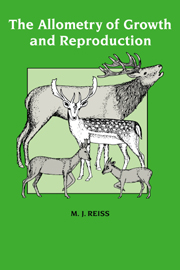Book contents
- Frontmatter
- Contents
- Preface
- 1 Introduction
- 2 The scaling of average daily metabolic rate and energy intake
- 3 Why do larger species invest relatively less in their offspring?
- 4 The intraspecific relationship of parental investment to female body weight
- 5 Growth and productivity
- 6 Quantitative models of body size
- 7 Sexual dimorphism in body size
- 8 Are larger species more dimorphic in body size?
- 9 Surface area/volume arguments in biology
- 10 Prospectus
- Glossary of mathematical terms
- References
- Index
6 - Quantitative models of body size
Published online by Cambridge University Press: 02 December 2009
- Frontmatter
- Contents
- Preface
- 1 Introduction
- 2 The scaling of average daily metabolic rate and energy intake
- 3 Why do larger species invest relatively less in their offspring?
- 4 The intraspecific relationship of parental investment to female body weight
- 5 Growth and productivity
- 6 Quantitative models of body size
- 7 Sexual dimorphism in body size
- 8 Are larger species more dimorphic in body size?
- 9 Surface area/volume arguments in biology
- 10 Prospectus
- Glossary of mathematical terms
- References
- Index
Summary
In this chapter existing quantitative models of body size are critically reviewed. Special attention is paid to Belovsky's (1978) model for moose, as this is the only attempt yet to predict numerically how males and females should differ in weight. The criticisms here of nearly all the other quantitative models of body size may appear rather negative. The purpose of this chapter is not, however, solely to condemn most previous work. Evidence is presented that the energy assimilated per unit time scales at about body weight to the two-thirds power in ruminants, and it is pointed out why quantitative predictions of optimal female adult body weight from the model of Chapter 3 are not yet feasible either.
A review of existing models
Pearson (1948)
Pearson (1948) argued that in a plot of metabolic rate (measured as cubic centimetres of O2 per hour per gram of body weight) on body weight for mammals, the extrapolated curve for shrews becomes asymptotic at about 2.5 g. Consequently, he maintained, no (adult) mammals are lighter than this, because such lighter animals would be unable to gather enough food to support their ‘infinitely rapid metabolism’. This argument is unconvincing. Smaller animals also eat more, relative to their body weight (Chapter 2).
If Pearson's theory was valid, it might be predicted that smaller species should spend more time feeding. Smaller birds do feed for longer (Hinde, 1952; Gibb, 1954; Pearson, 1968). However, the interspecific dependence of feeding time on size differs between taxa. Larger primates, for example, feed for longer (Clutton-Brock & Harvey, 1977), and the same may be true for ungulates (Eltringham, 1979).
- Type
- Chapter
- Information
- The Allometry of Growth and Reproduction , pp. 75 - 90Publisher: Cambridge University PressPrint publication year: 1989



